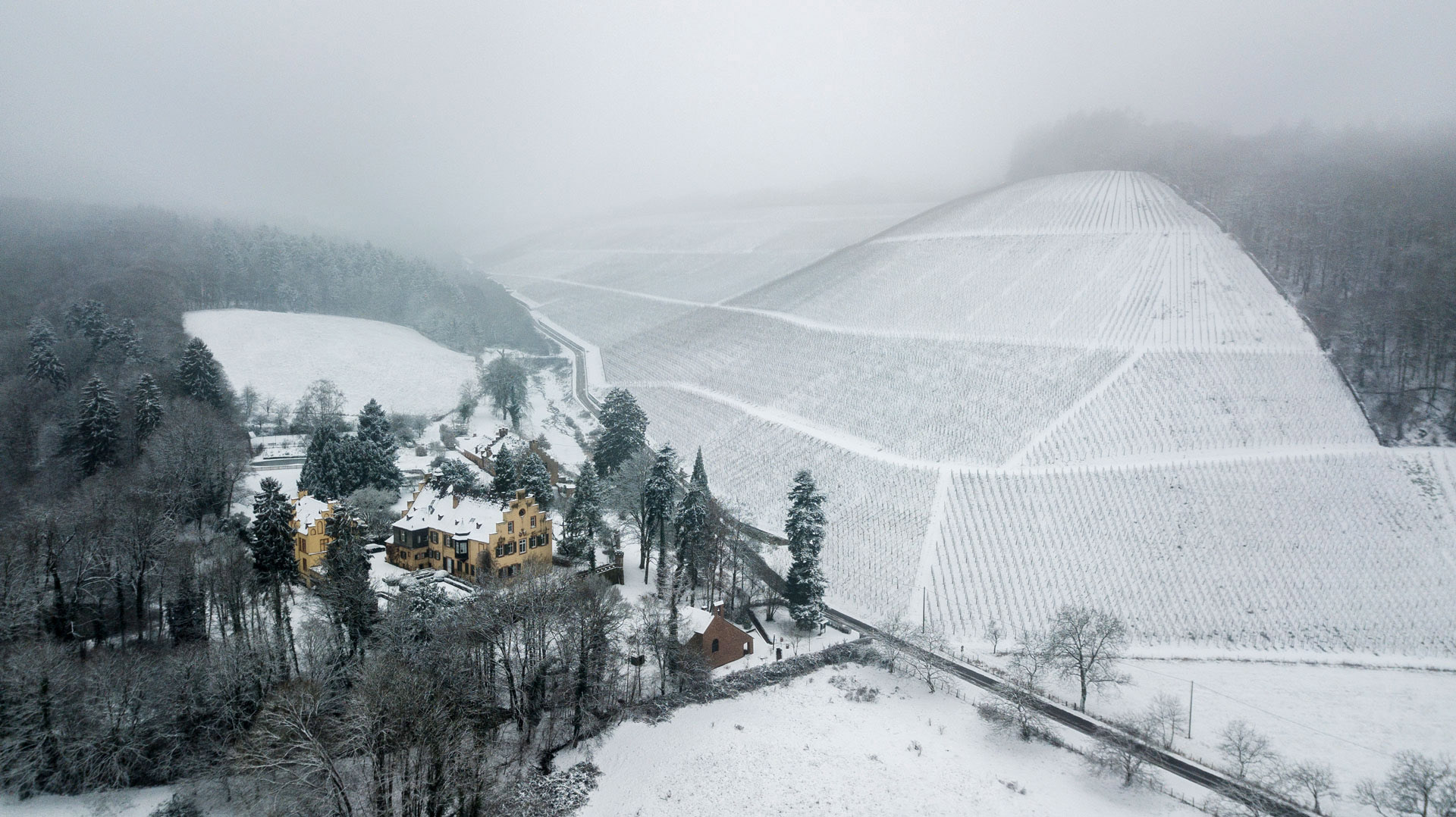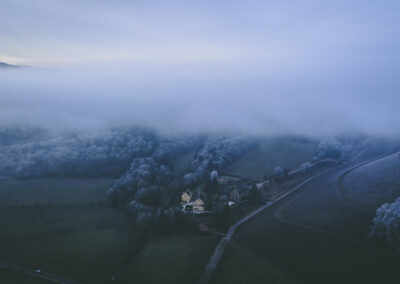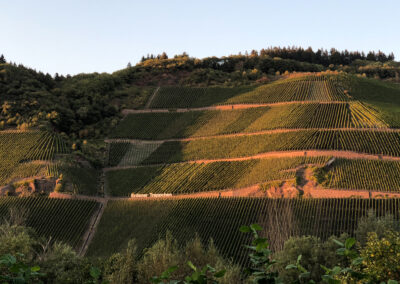This month we’re delving into one of the most fascinating aspects of viticulture: the influence of climate. From the rolling vineyards of temperate regions to the sun-soaked slopes of warmer locales, the climate plays a crucial role in shaping the flavors, aromas, and overall character of the wines we enjoy. As global temperatures rise and weather patterns become increasingly unpredictable, winemakers around the world are facing a new set of challenges and opportunities. The interplay between temperature, precipitation, and growing conditions can dramatically alter the profiles of different grape varieties, influencing everything from acidity and alcohol levels to the depth of fruit flavors.
Join us as we uncover the impact of climate on the world of wine and toast to the adaptability and resilience of the industry. Here’s to a deeper understanding of how climate shapes every glass!
The What, Where, and When of Climate
Let’s begin with the basics of climate and its impact on wine production. Climate determines where grapes are planted, what grapes are planted, and when grapes are harvested. It’s no surprise that certain grape varieties are better suited to some regions than others due to climate, but the soil type and overall geology of a region also play a role in wine expression.

Harvest at the Dr. Loosen Estate Vineyards along the Mosel River
Riesling is a great example of how climate can impact a wine’s characteristics. Riesling thrives in cool climates where the grapes can retain electric acidity, whereas when Riesling is grown in warm climates, it has less verve and energy. That said, excellent Rieslings are produced in warm climates, like Australia. We’ll continue to explore Riesling’s regional differences later in the newsletter.
In addition to where and what grape varieties should be planted, climate also determines when grapes are ready for harvest. In hotter climates, grapes are ready to be harvested sooner than those grown in cooler climates due to the higher number of bright sunny days and warm temperatures. Cool climate regions often benefit from longer hangtime on the vine to achieve optimum ripeness and greater flavor complexities.
The Role of Climate in Terroir Expression
Climate significantly impacts the suitability of agricultural products for specific regions, as well as determining overall crop yield and quality. Refer to this handy chart for a quick guide on evaluating wines.
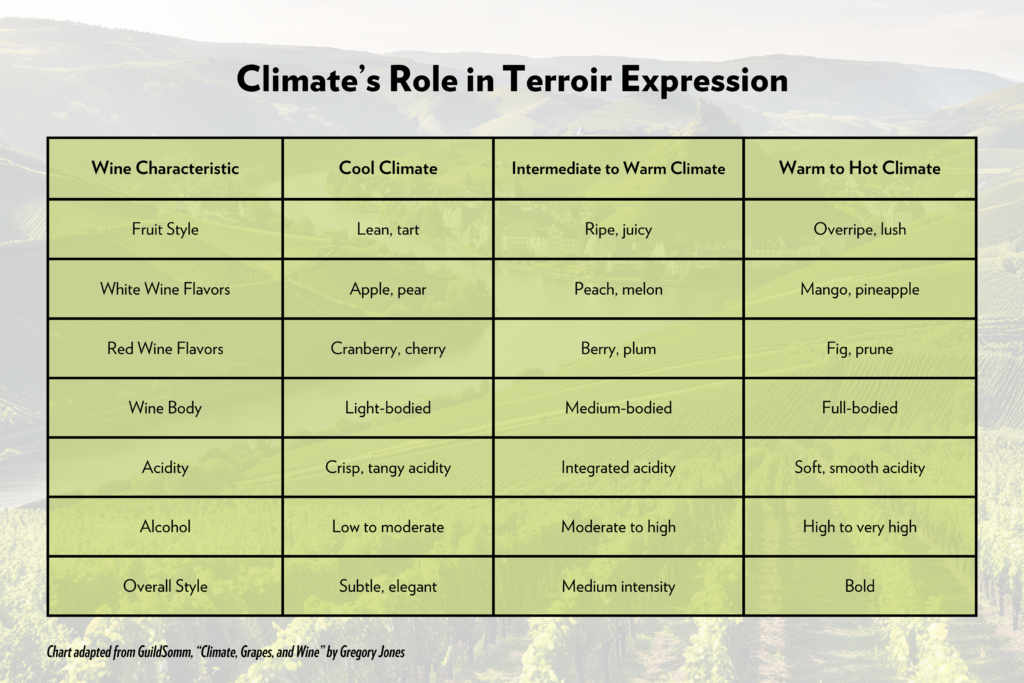
Chart adapted from the article, “Climate, Grapes, and Wine” by Gregory Jones
Grape varieties that thrive in cooler climates usually yield wines with a more delicate profile: lower alcohol, crisp acidity, a lighter body, and vibrant fruit flavors. In contrast, grapes grown in hotter climates produce wines that are more robust and intense, featuring higher alcohol content, softer acidity, a fuller body, and richer, darker fruit flavors. While soil composition also plays a role, its impact is often more nuanced, affecting subtle differences in fruit characteristics and wine styles within the same climate or region.
Impacts of Changing Climates on Wine Production
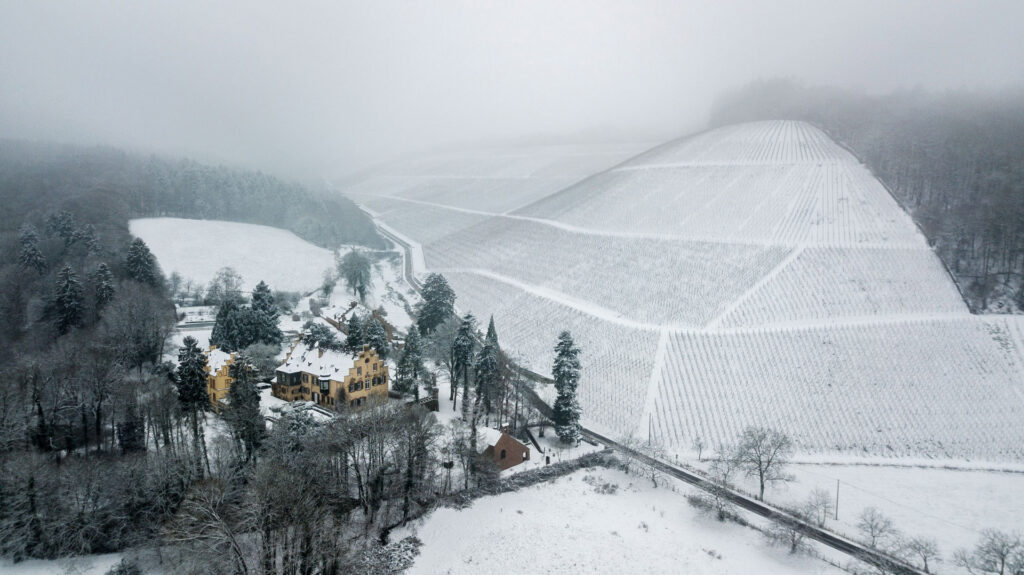
The Maximin Grünhaus Estate Blanketed in Winter Snow
Climates are changing around the world and these changes are greatly impacting vineyards and wine production. The most common examples of climate change seen in the wine industry are freak hailstorms, spring frosts, wildfires, prolonged heatwaves, and drought-like conditions. These changing weather patterns are unpredictable and pose challenges to winemakers that they must overcome each vintage.
The most obvious effect of climate change in global wine regions is warmer temperatures. These warmer temperatures cause all stages of the wine growing cycle to occur earlier –– budding, flowering, fruit-set, verasion, and of course, harvest. These are all taking place an average of two weeks earlier than what is historically common. These warmer temperatures aren’t just impacting the last stages of the growing season in the summer, the winter has also been significantly impacted. Winters are now milder and are causing vines to come out of dormancy far earlier than they used to which makes them more vulnerable to frost damage.
On top of changing temperatures throughout the growing season, winemakers also now have to adjust to more extreme weather overall. Wildfires not only threaten properties and vines but vineyards not at direct threat of the flames may still be affected by smoke taint when wildfire haze lingers over the vines. Drought-like conditions only exacerbate the threats and impacts of wildfires. Winemakers around the world are tasked with the challenge of mitigating these impacts each vintage.
Winemaker Adaptations and Opportunities
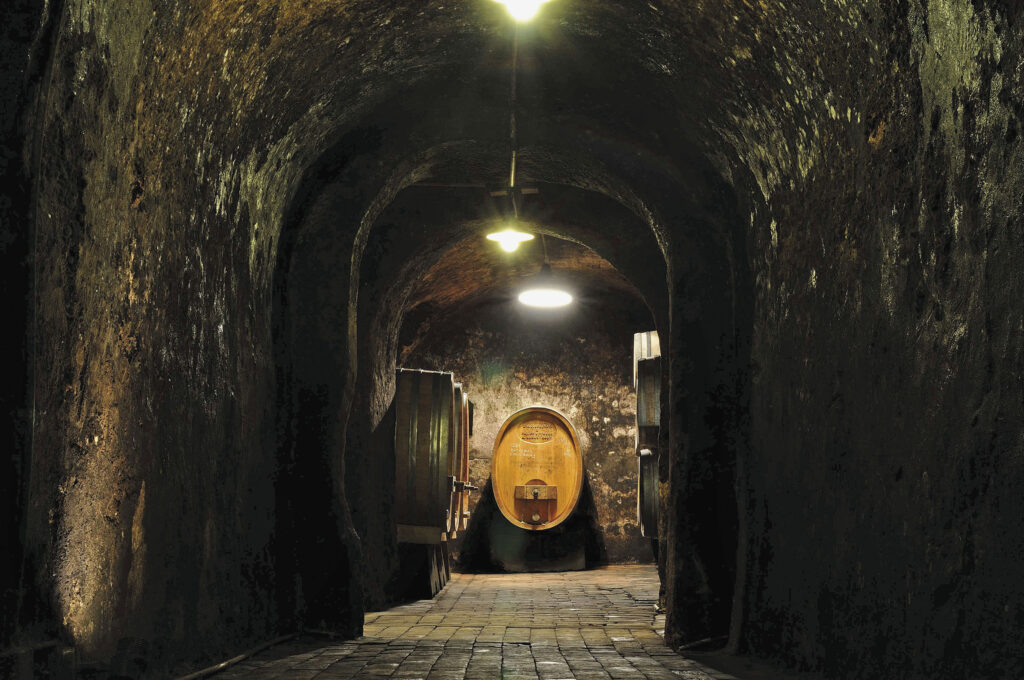
The Wittmann Cellar Caves
Counter-intuitively, climate change has brought forth opportunities to winemakers in cool climate regions. Historically, German wine regions have struggled to reach full ripeness in cool vintages. Thanks to rising temperatures, the threat of underripe fruit has almost disappeared. Furthermore, regions not known for wine production are beginning to explore the possibility of change. England, for example, has experienced prolonged heatwaves in recent years contributing to thriving wine regions. Typically a hotspot for sparkling wine production, we may begin to see Burgundian and even Alsatian varieties become the norm in England.
In order to adapt to the changing climate and extreme weather patterns, winemakers are moving to higher ground and seeking out once-inhospitable elevations for better weather and sun exposure. Others are reorienting their vineyards to work with, or against, the sun to protect the grapes from intense afternoon sun when heat and light are at their peak. Additionally, winemakers are looking to plant varieties that are better suited to the changing climate but that may not have a historical presence in the region. For example, some winemakers are planting varieties typically found in warm climates in former cool climates as temperatures rise.
Exploring Riesling’s Regional Climate Differences
Riesling is renowned for its exceptional ability to reflect its terroir, making it one of the most expressive grape varieties. The unique characteristics and complexities of Riesling are profoundly shaped by the region’s climate and soil. As a result, Riesling cultivated in various regions yields wines with distinct and diverse profiles, each showcasing the specific influences of its growing environment.
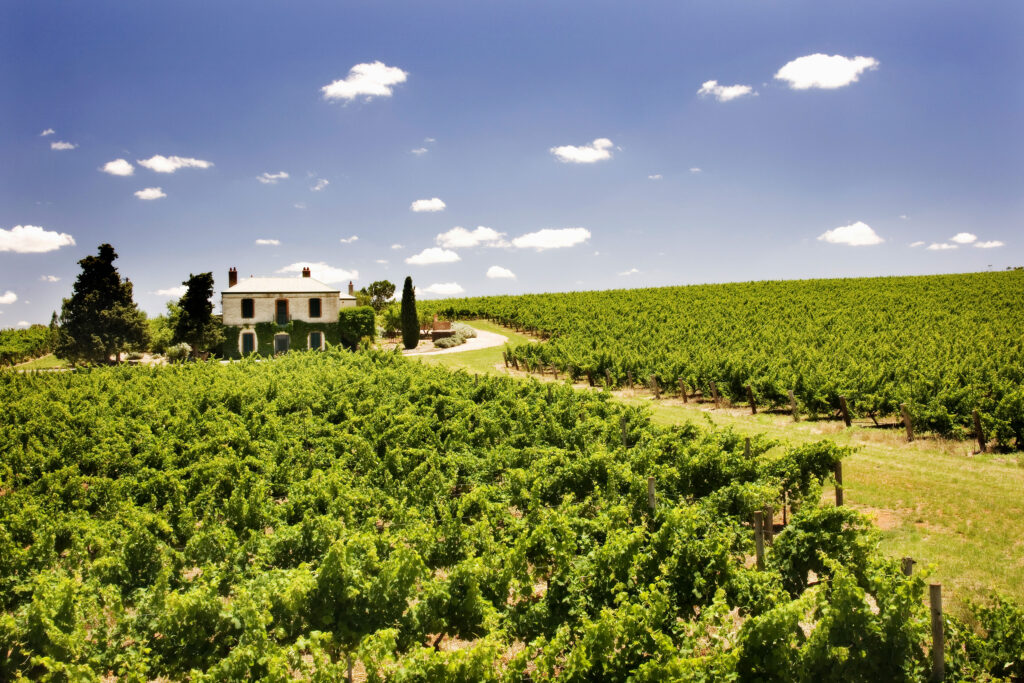
The Jim Barry Florita Vineyard in Australia’s Clare Valley
German Riesling
Germany is perfectly suited to Riesling which explains why all 13 of the country’s wine regions produce this variety –– it’s also the world’s largest producer of Riesling. Considered a cool climate region, Germany’s vineyards experience less sunshine and lower temperatures throughout the growing season compared to other regions.
Mosel Rieslings are typically delicate and have intense minerality thanks to the slate soil it’s grown on. The steep vineyard slopes that line the Mosel River retain heat well and allow for longer hang time resulting in balanced minerality and bracing, yet balanced acidity. Rieslings from the Rheingau region are fuller-bodied and have structured acidity. Moving south, Rheinhessen Rieslings have more mild acidity, a medium body, and stone fruit flavors. Further south in the warm, dry Pfalz, Rieslings are full-bodied and express flavors of orchard fruit as well as earthy and spicy elements.
Oregon and Washington Riesling
Produced in both dry and sweet styles, Oregon and Washington are also cool climate regions known for producing world-class Rieslings. Rieslings produced here are typically off-dry with floral and tropical fruit flavors. These wines also tend to have higher acidity than other wines produced here. The most prominent Riesling-producing region in these states is the Columbia Valley AVA where cool evenings offset high summer temperatures experienced during the day to retain the crisp acidity.
Australian Riesling
Australia is considerably warmer and drier than other regions known for Riesling, but this microclimate is well suited to the variety. In high-elevation areas, such as the Clare Valley, temperatures drop at night which preserves Riesling’s iconic acidity. Australian Rieslings are known for lemon and lime flavors, in addition to white flowers, orange blossoms, and tropical fruit. These Rieslings often have higher alcohol content and a fuller body than other Riesling regions.
As we wrap up this exploration of climate’s influence on wine, it’s clear that the interplay between weather and viticulture is both complex and fascinating. Winemakers are responding with innovation and resilience, adapting their practices to preserve the quality and character of their wines while embracing the opportunities presented by a changing climate. From experimenting with new grape varieties to refining vineyard management techniques, the future of wine is poised to be as dynamic and diverse as the landscapes it springs from.

